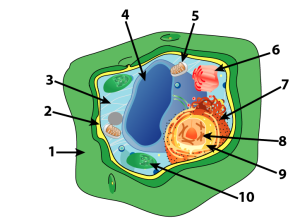Click the following link for a DNA Structure and Replication Student Learning Guide
1. Introduction
![]() DNA stands for deoxyribonucleic acid. Its function is
DNA stands for deoxyribonucleic acid. Its function is
- To transmit hereditary information from one generation to the next.
- To control the cell by determining which proteins (and RNAs, a close relative of DNA) the cell will produce. This, in turn, determines how a single cell develops into a complex, integrated, multicellular organism.
2. Three Key DNA-related processes: Replication, Transcription, and Translation
2a. Replication
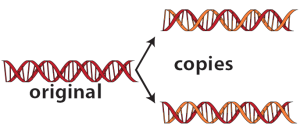
The process by which cells copy their DNA is called replication.
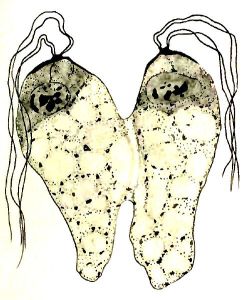
In a unicellular (single-celled) species, DNA replication is one of the key parts of reproduction. To reproduce, a single-celled organism grows bigger, replicates its DNA, then divides itself in two. You can see a unicellular organism (Collodictyon) dividing into two on the right.
For multicellular organisms like us, DNA replication is required for growth, repair, and reproduction.
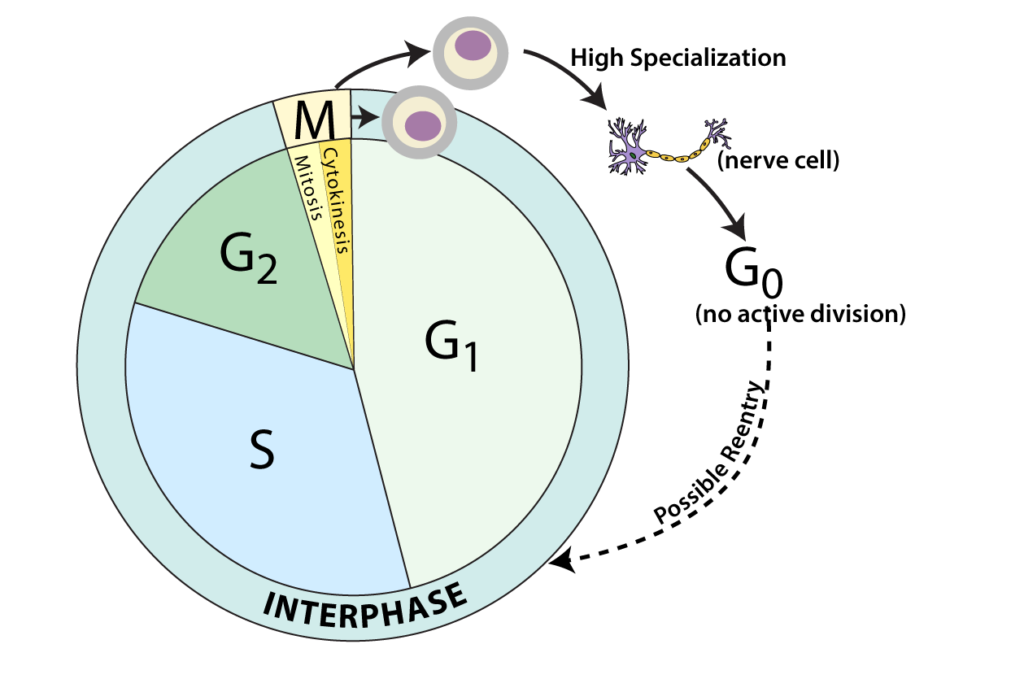 As we’ve seen in a previous tutorial, DNA replication is a key part of the cell cycle. It occurs during the S phase of interphase.
As we’ve seen in a previous tutorial, DNA replication is a key part of the cell cycle. It occurs during the S phase of interphase.
2b. DNA makes RNA makes protein: Transcription and Translation
DNA controls the cell by specifying which proteins the cell makes.
DNA is information. But on its own, DNA is powerless. By contrast, proteins can do things. As enzymes, protein can take molecules apart or put them together. As muscle tissue, protein can make organisms move.
Here’s how DNA controls the cell through protein:
-
- DNA stays in the nucleus. Through transcription, messages from DNA are sent to the cytoplasm.
- These messages are in the form of RNA (a molecule that is closely related to DNA).
- Through translation, RNA messages are changed into protein, the action molecule of the cell.
- The key sequence is DNA → transcription? RNA → translation → protein.
DNA makes RNA makes protein is a central idea in biology. In fact, it’s known as CENTRAL DOGMA of molecular genetics. Molecular genetics is the field that studies the molecules of inheritance: their structure, function, and behavior.
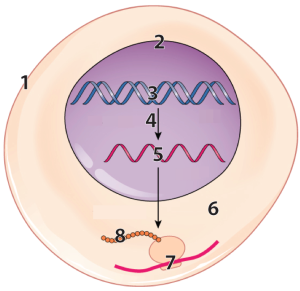 We’ll spend a lot of time clarifying these processes in later tutorials, but the key ideas are captured in the diagram to the right.
We’ll spend a lot of time clarifying these processes in later tutorials, but the key ideas are captured in the diagram to the right.
- The cell membrane is at 1. The nuclear membrane is at 2.
- DNA (3) gets transcribed (4) into RNA (5).
- The RNA leaves the nucleus and enters the cytoplasm (6)
- In the cytoplasm, RNA gets translated into protein (8). As we’ll see, translation happens at ribosomes (7)
DNA makes RNA makes protein is the essential recipe for life.
3. Where DNA is found
3a. In eukaryotes
In eukaryotic cells, most of the DNA is found in the chromosomes, within the nucleus. In the diagram of a plant cell to your left, the chromosomes are shown at number 8. (Note that this drawing is slightly inaccurate. Most of the time the DNA is spread throughout the nucleus. The “X” shape only appears when the cell is about to divide).
Two eukaryotic organelles, mitochondria (5) and chloroplasts (10), also have DNA. These organelles have DNA because they evolved from once-independent prokaryotic cells that long ago took up residence inside a larger, eukaryotic cell. The DNA in these organelles is similar to the prokaryotic DNA described below.
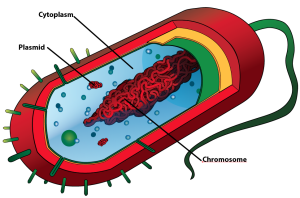
3b. In prokaryotes
Prokaryotic cells lack a nucleus and complex, membrane-bound organelles. This cell type is found, most notably, in bacteria.
In prokaryotes, most of the DNA is found in the cytoplasm, in a single, looped chromosome (looped because the end is connected to the beginning). Some additional DNA is located outside the main chromosome in small loops of DNA called plasmids. Bacterial cells use plasmids to exchange genes with one another. As we’ll see later in the course, plasmids are also essential tools for introducing new genes into bacteria during the process of genetic engineering.
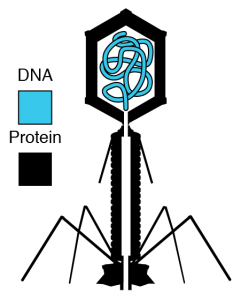 3.c. In viruses
3.c. In viruses
Viruses consist of DNA (or RNA) surrounded by protein. There can also be additional layers outside the protein. Viruses attack cells and use the cell’s machinery to make more viruses.
4. Quiz: DNA Concepts
[qwiz style = “border: 3px solid black; width: 550px !important; min-height: 350px !important;” random = “true” qrecord_id=”sciencemusicvideosMeister1961-DNA Concepts (M13)”]
[h] Quiz: DNA Concepts
[i]
[q labels = “top”]
[l]main bacterial chromosome
[f*] Great!
[fx] No, that’s not correct. Please try again.
[l]plasmid
[f*] Correct!
[fx] No, that’s not correct. Please try again.
[l]cytoplasm
[f*] Great!
[fx] No. Please try again.
[q labels = “top”]
[l]RNA
[f*] Great!
[fx] No, that’s not correct. Please try again.
[l]translation of RNA to protein
[f*] Correct!
[fx] No, that’s not correct. Please try again.
[l]DNA
[f*] Excellent!
[fx] No, that’s not correct. Please try again.
[l]cell membrane
[f*] Excellent!
[fx] No. Please try again.
[l]cytoplasm
[f*] Good!
[fx] No, that’s not correct. Please try again.
[l]protein
[f*] Good!
[fx] No, that’s not correct. Please try again.
[l]transcription of DNA to RNA
[f*] Great!
[fx] No, that’s not correct. Please try again.
[l]nuclear membrane
[f*] Excellent!
[fx] No, that’s not correct. Please try again.
[q labels = “top”]Label the four parts of a plant cell that have a direct connection to DNA.
[l]chromosomes
[f*] Excellent!
[fx] No, that’s not correct. Please try again.
[l]chloroplast
[f*] Correct!
[fx] No, that’s not correct. Please try again.
[l]mitochondria
[f*] Correct!
[fx] No, that’s not correct. Please try again.
[l]nuclear membrane
[f*] Great!
[fx] No. Please try again.
[q multiple_choice=”true”] Copying DNA is known as ____________
[c]IHRyYW5zY3JpcHRpb24=[Qq]
[f]IE5vLiBZb3UmIzgyMTc7cmUgbG9va2luZyBmb3IgdGhlwqB3b3JkIHRoYXQmIzgyMTc7c8KgdXNlZCB3aGVuIHNwb2tlbiB3b3Jkc8KgYXJlIGNoYW5nZWQgaW50byB3cml0dGVuIHdvcmRz[Qq]
[c]IHJlcGxp Y2F0aW9u[Qq]
[f]IFllcyEgQ29weWluZyBETkEgaXMga25vd24gYXMgcmVwbGljYXRpb24u[Qq]
[c]IHRyYW5zbGF0aW9u[Qq]
[f]IE5vLiBUcmFuc2xhdGlvbsKgaXMgbWFraW5nIHByb3RlaW7CoGZyb20gUk5BLg==[Qq]
[q multiple_choice=”true”] The process of making RNA from DNA is known as ________
[c]IHRyYW5zY3 JpcHRpb24=[Qq]
[f]IFllcy4gVGhlIHByb2Nlc3Mgb2YgbWFraW5nIFJOQSBmcm9tIEROQSBpcyBrbm93biBhcyA=dHJhbnNjcmlwdGlvbg==Lg==[Qq]
[c]IHJlcGxpY2F0aW9u[Qq]
[f]IE5vLiA=UmVwbGljYXRpb24=IG1lYW5zIA==Y29weWluZw==LiBZb3UmIzgyMTc7cmUgbG9va2luZyBmb3IgdGhlIHdvcmQgdGhhdCYjODIxNztzIHVzZWQgd2hlbiB5b3UgdGFrZSBhdWRpbyBhbmQgd3JpdGUgZG93biB0aGUgd29yZHMu[Qq]
[c]IHRyYW5zbGF0aW9u[Qq]
[f]IE5vLiBUcmFuc2xhdGlvbiBpbnZvbHZlcyB0YWtpbmcgUk5BIGFuZCBtYWtpbmcgaXQgaW50byBwcm90ZWluLiBZb3UmIzgyMTc7cmUgbG9va2luZyBmb3IgdGhlIHdvcmQgdGhhdCYjODIxNztzIHVzZWQgd2hlbiB5b3UgdGFrZSBhdWRpbyBhbmQgd3JpdGUgZG93biB0aGUgd29yZHMu[Qq]
[q multiple_choice=”true”] The process of making protein based on RNA instructions is known as ________
[c]IHRyYW5zY3JpcHRpb24=[Qq]
[f]IE5vLsKgVHJhbnNjcmlwdGlvbiBpcyBtYWtpbmcgUk5BIGZyb20gRE5BLiBZb3UmIzgyMTc7cmUgbG9va2luZyBmb3IgdGhlIHdvcmQgdGhhdCYjODIxNztzIHVzZWQgd2hlbiBzb21lb25lIGNoYW5nZXMgdGhlIHdvcmRzIGluIG9uZSBsYW5ndWFnZSBpbnRvIGFub3RoZXIgbGFuZ3VhZ2Uu[Qq]
[c]IHJlcGxpY2F0aW9u[Qq]
[f]IE5vLiA=UmVwbGljYXRpb24=IG1lYW5zIA==Y29weWluZw==LiBZb3UmIzgyMTc7cmUgbG9va2luZyBmb3IgdGhlIHdvcmQgdGhhdCYjODIxNztzIHVzZWQgd2hlbiBzb21lb25lIGNoYW5nZXMgdGhlIHdvcmRzIGluIG9uZSBsYW5ndWFnZSBpbnRvIGFub3RoZXIgbGFuZ3VhZ2Uu[Qq]
[c]IHRyYW5z bGF0aW9u[Qq]
[f]IFllcy4gVHJhbnNsYXRpb24gaW52b2x2ZXMgdGFraW5nIFJOQSBhbmQgbWFraW5nIGl0IGludG8gcHJvdGVpbi4=[Qq]
[q] In the diagram below, DNA is shown at
[textentry single_char=”true”]
[c]ID M=[Qq]
[f]IFllcy4gSW4gdGhlIGRpYWdyYW0gYWJvdmUsIEROQSBpcyBzaG93biBhdCAzLg==[Qq]
[c]ICo=[Qq]
[f]IE5vLiBMb29rIGZvciB0aGUgZG91YmxlIGhlbGl4Lg==[Qq]
[q] In the diagram below, RNA inside the nucleus is shown at
[textentry single_char=”true”]
[c]ID U=[Qq]
[f]IFllcy4gSW4gdGhlIGRpYWdyYW0gYWJvdmUsIFJOQSBpbnNpZGUgdGhlIG51Y2xldXMgaXMgc2hvd24gYXQgNS4=[Qq]
[c]ICo=[Qq]
[f]IE5vLiBMb29rIGZvciBhIHNpbmdsZSBoZWxpeCAoY29ya3NjcmV3IHNoYXBlKSBpbnNpZGUgdGhlIG51Y2xldXMu[Qq]
[q] In the diagram below, newly made protein is shown at
[textentry single_char=”true”]
[c]ID g=[Qq]
[f]IFllcy4gSW4gdGhlIGRpYWdyYW0gYWJvdmUswqBuZXdseSBtYWRlIHByb3RlaW4gaXMgc2hvd24gYXQgOC4=[Qq]
[c]ICo=[Qq]
[f]IE5vLiBMb29rIGZvciBzb21ldGhpbmcgYmVpbmcgbWFkZSBieSB0aGUgcmlib3NvbWUgKHNob3duIGF0IDcp[Qq]
[q] In the diagram below, a ribosome is shown at
[textentry single_char=”true”]
[c]ID c=[Qq]
[f]IFllcy4gSW4gdGhlIGRpYWdyYW0gYWJvdmUsIGEgcmlib3NvbWUgaXMgc2hvd24gYXQgNw==[Qq]
[c]ICo=[Qq]
[f]IE5vLiBMb29rIGZvciBzb21ldGhpbmcgdGhhdCYjODIxNztzIHJlYWRpbmcgUk5BIGFuZCBtYWtpbmcgcHJvdGVpbi4=
Cg==[Qq]
[q] The central dogma of molecular genetics is [hangman] makes RNA, makes protein.
[c]IEROQQ==
Cg==[Qq]
[q] DNA stands for [hangman] acid
[c]IGRlb3h5cmlib251Y2xlaWM=
Cg==[Qq]
[q] The copying of DNA is called [hangman]
[c]IHJlcGxpY2F0aW9u[Qq]
[q] The central dogma of molecular genetics is DNA makes RNA makes [hangman].
[c]IHByb3RlaW4=[Qq]
[q] In a eukaryotic cell, DNA always stays in the [hangman].
[c]IG51Y2xldXM=[Qq]
[q] The word for the transfer of DNA information into RNA is [hangman].
[c]IHRyYW5zY3JpcHRpb24=[Qq]
[q] The word for the transfer of RNA information into protein is [hangman].
[c]IHRyYW5zbGF0aW9u[Qq]
[q] The “action molecule” of the cell is [hangman].
[c]IHByb3RlaW4=[Qq]
[q] The molecule which brings DNA information to the cytoplasm is [hangman].
[c]IFJOQQ==[Qq]
[q] In a eukaryotic cell, the DNA is organized into multiple [hangman].
[c]IGNocm9tb3NvbWVz[Qq]
[q] A cellular parasite that can have DNA or RNA as its genetic material is a [hangman].
[c]IHZpcnVz[Qq]
[q] A tiny circle of DNA found outside the main bacterial chromosome is a [hangman].
[c]IHBsYXNtaWQ=[Qq]
[q multiple_choice=”true”] Of the choices below, which is the only animal cell organelle that contains its own DNA?
[c]IDIgwqAgwqAgwqAg[Qq][c]IDMgwqAgwqAgwqAg[Qq][c]IDYgwqAgwqAgwqAg[Qq][c]IDcgwqAg wqAgwqAg[Qq][c]IDggwqAgwqAgwqAg[Qq][c]IDk=[Qq][f]IE5vLiBOdW1iZXIgMiBpcyBwb2ludGluZyB0byB0aGUgY2VsbCBtZW1icmFuZS4gVGhlcmUmIzgyMTc7cyBubyBETkEgdGhlcmUu
Cg==[Qq][f]IE5vLiBOdW1iZXIgMyBpcyBwb2ludGluZyB0byB0aGUgR29sZ2kgYXBwYXJhdHVzLiBUaGVyZSYjODIxNztzIG5vIEROQSB0aGVyZS4=[Qq]
[f]IE5vLiBOdW1iZXIgNiBpcyBwb2ludGluZyB0byB0aGUgcmlib3NvbWVzLiBUaGV5JiM4MjE3O3JlIG1hZGUgb2YgUk5BLCBub3QgRE5BLg==[Qq]
[f]IFllcy4gTnVtYmVyIDcgaXMgcG9pbnRpbmcgdG8gYSBtaXRvY2hvbmRyaW9uLiBNaXRvY2hvbmRyaWEgZXZvbHZlZCBmcm9tIGZyZWUtbGl2aW5nIHByb2thcnlvdGljIGJhY3RlcmlhbCBjZWxscywgYW5kIGhhdmUgdGhlaXIgb3duIEROQS4=[Qq]
[f]IE5vLiBOdW1iZXIgOMKgaXMgcG9pbnRpbmcgdG8gdGhlIGNlbnRyaW9sZXMuIFRoZXJlJiM4MjE3O3Mgbm8gRE5BIHRoZXJlLg==[Qq]
[f]IE5vLiBOdW1iZXIgOcKgaXMgcG9pbnRpbmcgdG8gdGhlIEVuZG9wbGFzbWljIFJldGljdWx1bS4gVGhlcmUmIzgyMTc7cyBubyBETkEgdGhlcmUu
Cg==Cg==[Qq][q multiple_choice=”true”] In a plant cell, which of the following organelles DOES NOT have DNA.
[c]IG1pdG9jaG9uZHJpb24=[Qq]
[f]IE5vLiBUaGUgbWl0b2Nob25kcmlvbiwgd2hpY2ggaXMgYW4gZXZvbHV0aW9uYXJ5IGRlc2NlbmRhbnQgb2YgYW7CoGluZGVwZW5kZW50IHByb2thcnlvdGljIGNlbGwsIGNvbnRhaW5zIGl0cyBvd24gRE5BLg==[Qq]
[c]IGNobG9yb3BsYXN0[Qq]
[f]IE5vLiBUaGUgY2hsb3JvcGxhc3QsIHdoaWNoIGlzIGFuIGV2b2x1dGlvbmFyeSBkZXNjZW5kYW50IG9mIGFuIGluZGVwZW5kZW50LCBwaG90b3N5bnRoZXRpYyBwcm9rYXJ5b3RpYyBjZWxsLCBjb250YWlucyBpdHMgb3duIEROQS4=[Qq]
[c]IG51Y2xldXM=[Qq]
[f]IE5vLiBUaGUgbnVjbGV1cyBpcyB0aGUgbWFpbiBzdG9yZWhvdXNlIG9mIHRoZSBjZWxsJiM4MjE3O3MgRE5BLg==[Qq]
[c]IEdvbGdpIGFw cGFyYXR1cw==[Qq]
[f]IFllcy4gVGhlIEdvbGdpIGFwcGFyYXR1cyBpcyBvbmUgb2YgbWFueSBjZWxsIG9yZ2FuZWxsZXMgdGhhdCBkb2VzIE5PVMKgY29udGFpbiBpdHMgb3duIEROQS4=
Cg==Cg==[Qq][q multiple_choice=”true”] In a eukaryotic cell, chromosomes are located in the
[c]IENlbGwgbWVtYnJhbmU=[Qq]
[f]IE5vLiBJbiBhIGV1a2FyeW90aWPCoGNlbGwsIGNocm9tb3NvbWVzIGFyZSBsb2NhdGVkIGluIGEgbWVtYnJhbmUtYm91bmQgb3JnYW5lbGxlIGluIHRoZSBjZW50ZXIgb2YgdGhlIGNlbGwuIFdoYXQgd291bGQgdGhhdCBiZT8=
Cg==[Qq]
[c]IG51Y2 xldXM=[Qq]
[f]IFllcy4gSW4gYSBldWthcnlvdGljIGNlbGwsIGNocm9tb3NvbWVzIGFyZSBsb2NhdGVkIGluIHRoZSBudWNsZXVzLg==
Cg==[Qq]
[c]IGVuZG9wbGFzbWljIHJldGljdWx1bQ==[Qq]
[f]IE5vLiBJbiBhIGV1a2FyeW90aWMgY2VsbCwgY2hyb21vc29tZXMgYXJlIGxvY2F0ZWQgaW4gYSBtZW1icmFuZS1ib3VuZCBvcmdhbmVsbGUgaW4gdGhlIGNlbnRlciBvZiB0aGUgY2VsbC4gV2hhdCB3b3VsZCB0aGF0IGJlPw==
Cg==[Qq]
[c]IHJpYm9zb21lcw==[Qq]
[f]IE5vLiBJbiBhIGV1a2FyeW90aWPCoGNlbGwsIGNocm9tb3NvbWVzIGFyZSBsb2NhdGVkIGluIGEgbWVtYnJhbmUtYm91bmQgb3JnYW5lbGxlIGluIHRoZSBjZW50ZXIgb2YgdGhlIGNlbGwuIFdoYXQgd291bGQgdGhhdCBiZT8=
Cg==Cg==[Qq]
[q multiple_choice=”true”] The diagram below represents
[c]IHJlcGxp Y2F0aW9u[Qq]
[f]IFllcy4gUmVwbGljYXRpb24gaXMgdGhlIGNvcHlpbmcgb2YgbmV3IEROQSBmcm9tIHBhcmVudCBETkEu[Qq]
[c]IHRyYW5zY3JpcHRpb24=[Qq]
[f]IE5vLiBUcmFuc2NyaXB0aW9uIGlzIHRoZSB0cmFuc2ZlciBvZiBETkEgaW5mb3JtYXRpb24gaW50byBSTkEu[Qq]
[c]IHRyYW5zbGF0aW9u[Qq]
[f]IE5vLiBUcmFuc2xhdGlvbiBpcyB0aGUgdHJhbnNmZXIgb2YgUk5BIGluZm9ybWF0aW9uIGludG8gcHJvdGVpbi4=
Cg==Cg==[Qq][q multiple_choice=”true”] Tiny circles of DNA outside the main bacterial chromosome are called
[c]IHJlcGxpY29ucw==[Qq]
[f]IE5vLiAmIzgyMjA7UmVwbGljb25zJiM4MjIxOyBtYWtlcyBzZW5zZSwgYnV0IGl0JiM4MjE3O3MgYSBtYWRlLXVwIHRlcm0gKHNvcnJ5ISkuIEhlcmUmIzgyMTc7cyBhIGhpbnQ6IHRoZXNlIGxpdHRsZSBjaXJjbGVzIG9mIEROQSBhcmUgZm91bmQgaW4gdGhlIGNlbGwmIzgyMTc7cyBjeXRvUExBU00u[Qq]
[c]IHBsYX NtaWRz[Qq]
[f]IFllcy4gVGhlc2UgbGl0dGxlIGNpcmNsZXPCoG9mIGV4dHJhLWNocm9tb3NvbWFswqBETkEgYXJlIGtub3duIGFzIHBsYXNtaWRzLg==[Qq]
[c]IGNocm9tYXRlbGxlcw==[Qq]
[f]IE5vLiAmIzgyMjA7Q2hyb21hdGVsbGVzJiM4MjIxOyBpcyBhIG1hZGUtdXAgdGVybSAoc29ycnkhKS4gSGVyZSYjODIxNztzIGEgaGludDogdGhlc2UgbGl0dGxlIGNpcmNsZXMgb2YgRE5BIGFyZSBmb3VuZCBpbiB0aGUgY2VsbCYjODIxNztzIGN5dG9QTEFTTS4=
Cg==Cg==[Qq][q multiple_choice=”true”] In the diagram below, translation is represented by which number?
[c]IDHCoMKgIA==[Qq][c]IDLCoMKgIA==[Qq][c]IDMgwqAg[Qq][c]IDTCoMKgwqDCoCA=[Qq][c]IDXCoMKgwqDCoCA=[Qq][c]IDbCoMKgwqDCoCA=[Qq][c]ID c=
[f]IE5vLiAxIHJlcHJlc2VudHMgdGhlIGNlbGwgbWVtYnJhbmUuwqA=VHJhbnNsYXRpb24=IGlzIHdoZW4gaW5zdHJ1Y3Rpb25zIGluIFJOQSBhcmUgY29udmVydGVkIGludG8gcHJvdGVpbi4gV2hpY2ggbnVtYmVyIGNvdWxkIHJlcHJlc2VudCB0aGlzIHByb2Nlc3M/[Qq]
[f]IE5vLiAyIHJlcHJlc2VudHMgdGhlIG51Y2xlYXIgbWVtYnJhbmUuwqA=VHJhbnNsYXRpb24=IGlzIHdoZW4gaW5zdHJ1Y3Rpb25zIGluIFJOQSBhcmUgY29udmVydGVkIGludG8gcHJvdGVpbi4gV2hpY2ggbnVtYmVyIGNvdWxkIHJlcHJlc2VudCB0aGlzIHByb2Nlc3M/[Qq]
[f]IE5vLiAzIHJlcHJlc2VudHMgRE5BLsKgVHJhbnNsYXRpb24=IGlzIHdoZW4gaW5zdHJ1Y3Rpb25zIGluIFJOQSBhcmUgY29udmVydGVkIGludG8gcHJvdGVpbi4gV2hpY2ggbnVtYmVyIGNvdWxkIHJlcHJlc2VudCB0aGlzIHByb2Nlc3M/[Qq]
[f]IE5vLiA0IHJlcHJlc2VudHMgdHJhbnNjcmlwdGlvbi4gRHVyaW5nIHRyYW5zY3JpcHRpb24sIEROQSBpbmZvcm1hdGlvbiBpcyB0cmFuc2ZlcnJlZCB0byBSTkEuwqA=VHJhbnNsYXRpb24=IGlzIHdoZW4gaW5zdHJ1Y3Rpb25zIGluIFJOQSBhcmUgY29udmVydGVkIGludG8gcHJvdGVpbi4gV2hpY2ggbnVtYmVyIGNvdWxkIHJlcHJlc2VudCB0aGlzIHByb2Nlc3M/[Qq]
[f]IE5vIChidXQgeW91JiM4MjE3O3JlIGNsb3NlKS4gNSByZXByZXNlbnRzIFJOQS7CoA==VHJhbnNsYXRpb24=IGlzIHdoZW4gaW5zdHJ1Y3Rpb25zIGluIFJOQSBhcmUgY29udmVydGVkIGludG8gcHJvdGVpbi4gV2hpY2ggbnVtYmVyIGNvdWxkIHJlcHJlc2VudCB0aGlzIHByb2Nlc3M/[Qq]
[f]IE5vLiA2IHJlcHJlc2VudHMgdGhlIGN5dG9wbGFzbS7CoA==VHJhbnNsYXRpb24=IGlzIHdoZW4gaW5zdHJ1Y3Rpb25zIGluIFJOQSBhcmUgY29udmVydGVkIGludG8gcHJvdGVpbi4gV2hpY2ggbnVtYmVyIGNvdWxkIHJlcHJlc2VudCB0aGlzIHByb2Nlc3M/[Qq]
[f]IFllcy4gNyByZXByZXNlbnRzIHRyYW5zbGF0aW9uIG9yIHByb3RlaW4gc3ludGhlc2lzLiA=VHJhbnNsYXRpb24=IGlzIHdoZW4gaW5zdHJ1Y3Rpb25zIGluIFJOQSBhcmUgY29udmVydGVkIGludG8gcHJvdGVpbi4=
Cg==[Qq][q multiple_choice=”true”] Which number is pointing to the main bacterial chromosome?
[c]IDE=[Qq]
[f]IE5vLiAxIGlzIHBvaW50aW5nIHRvIGEgcGxhc21pZC4=[Qq]
[c]IDI=[Qq]
[f]IE5vLiAyIGlzIHBvaW50aW5nIHRvIHRoZSBjeXRvcGxhc20u[Qq]
[c]ID M=[Qq]
[f]IFllcy4gMyBpcyBwb2ludGluZyB0byB0aGUgbWFpbiBiYWN0ZXJpYWzCoGNocm9tb3NvbWUu
Cg==Cg==[Qq][q multiple_choice=”true”] Your genes are made of
[c]IHByb3RlaW4=[Qq]
[f]IE5vLiBZb3VyIGdlbmVzIA==Y29kZQ==IGZvciBwcm90ZWluLCBidXQgdGhleSYjODIxNztyZSBub3QgbWFkZSBvZiBETkEu[Qq]
[c]IERO QQ==[Qq]
[f]IFllcy4gwqBZb3VyIGdlbmVzIGFyZSBtYWRlIG9mIEROQS4=[Qq]
[c]IFJOQQ==[Qq]
[f]IE5vLiBSTkEgaXMgYSBtZXNzZW5nZXIgb2YgZ2VuZXRpYyBpbmZvcm1hdGlvbi4gV2hhdCBpcyB0aGUgbW9sZWN1bGUgdGhhdCBoYXMgdGhlIGdlbmV0aWMgaW5mb3JtYXRpb24gdGhhdCB5b3UgaW5oZXJpdD8=
Cg==Cg==[Qq][q multiple_choice=”true”] The phrase “DNA makes RNA makes protein” is also known as molecular genetics.
[c]IGNvcmUgY29uY2VwdA==[Qq]
[f]IE5vLiAmIzgyMjA7RE5BIG1ha2VzIFJOQSBtYWtlcyBwcm90ZWluJiM4MjIxOyBpcyBhIGNvcmUgY29uY2VwdCBpbiBtb2xlY3VsYXIgZ2VuZXRpY3MsIGJ1dCB0aGlzIGNvbmNlcHQgaXMgc28gaW1wb3J0YW50IHRoYXQgaXQgaGFzIGEgc3BlY2lhbCBuYW1lLg==[Qq]
[c]IGtleSBpZGVh[Qq]
[f]IE5vLiAmIzgyMjA7RE5BIG1ha2VzIFJOQSBtYWtlcyBwcm90ZWluJiM4MjIxOyBpcyBhIGtleSBpZGVhIGluIG1vbGVjdWxhciBnZW5ldGljcywgYnV0IHRoaXMgY29uY2VwdCBpcyBzbyBpbXBvcnRhbnQgdGhhdCBpdCBoYXMgYSBzcGVjaWFsIG5hbWUu[Qq]
[c]IGNlbnRyYW wgZG9nbWE=[Qq]
[f]IFllcy4gJiM4MjIwO0ROQSBtYWtlcyBSTkEgbWFrZXMgcHJvdGVpbiYjODIyMTsgaXPCoHRoZSBjZW50cmFsIGRvZ21hIG9mIG1vbGVjdWxhciBnZW5ldGljcy4=
Cg==Cg==[Qq][q multiple_choice=”true”] Which number is pointing to a plasmid?
[c]ID E=[Qq]
[f]IFllcy4gMSBpcyBwb2ludGluZyB0byBhIHBsYXNtaWQuIFBsYXNtaWRzIGFyZSBzbWFsbCBsb29wcyBvZiBETkEgb3V0c2lkZSB0aGUgbWFpbiBjaHJvbW9zb21lLg==[Qq]
[c]IDI=[Qq]
[f]IE5vLiAyIGlzIHBvaW50aW5nIHRvIHRoZSBjeXRvcGxhc20u[Qq]
[c]IDM=[Qq]
[f]IE5vLiAzIGlzIHBvaW50aW5nIHRvIHRoZSBtYWluIGJhY3RlcmlhbMKgY2hyb21vc29tZS4=
Cg==Cg==[Qq][q multiple_choice=”true”] _______ always stays in the nucleus. It controls the cell by sending out messages in the form of _______
[c]IFJOQeKApi5wcm90ZWlu[Qq]
[f]IE5vLiBSTkEgaXMgdHJhbnNjcmliZWQgaW4gdGhlIG51Y2xldXMgYW5kIHRoZW4gbW92ZXMgdG8gdGhlIGN5dG9wbGFzbS4=[Qq]
[c]IEROQSYjODIzMDtwcm90ZWlu[Qq]
[f]IE5vLiBZb3UmIzgyMTc7cmUgcmlnaHQgYWJvdXQgRE5BLCBidXQgdGhlcmUmIzgyMTc7cyBhbm90aGVyIG1vbGVjdWxlIHRoYXQgYnJpbmdzIEROQSYjODIxNztzIG1lc3NhZ2VzIG91dCB0byB0aGUgY3l0b3BsYXNtLg==[Qq]
[c]IFJOQSYjODIzMDtETkE=[Qq]
[f]IE5vLiBZb3UmIzgyMTc7dmUgZ290IHRoZSB0d28gcmV2ZXJzZWQu[Qq]
[c]IEROQSYjOD IzMDtSTkE=[Qq]
[f]IFllcyHCoA==RE5BwqBhbHdheXMgc3RheXMgaW4gdGhlIG51Y2xldXMuIEl0IGNvbnRyb2xzIHRoZSBjZWxsIGJ5IHNlbmRpbmcgb3V0IG1lc3NhZ2VzIGluIHRoZSBmb3JtIG9mIA==Uk5BLg==
[Qq][q multiple_choice=”true”] If a cell were an office, the molecule that would act like a boss who always stays in the office would be
[c]IHByb3RlaW4=[Qq]
[f]IE5vLiBQcm90ZWluIGlzIHRoZSB3b3JrZXIgbW9sZWN1bGUgaW4gdGhlIGNlbGwuIFdobyYjODIxNztzIHRoZSBib3NzPw==[Qq]
[c]IERO QQ==[Qq]
[f]IFllcy4gRE5BLCBpbiBldWthcnlvdGljIGNlbGxzLCBhbHdheXMgc3RheXMgaW4gdGhlIG51Y2xldXMuIFRoYXQgbWFrZXMgaXQgc29tZXdoYXQgbGlrZcKgYSBib3NzIHdobyBhbHdheXMgc3RheXMgaW4gdGhlIG9mZmljZS4=[Qq]
[c]IFJOQQ==[Qq]
[f]IE5vLiBSTkEgaXMgYWx3YXlzIG1vdmluZyBmcm9tIHRoZSBudWNsZXVzIHRvIHRoZSBjeXRvcGxhc20uIElmIHRoZSBudWNsZXVzIHdlcmUgdGhlIG9mZmljZSwgdGhlbiB0aGlzIGFuYWxvZ3kgZG9lc24mIzgyMTc7dCBmaXQu
Cg==Cg==[Qq][q multiple_choice=”true”] In the diagram below, transcription is represented by which number?
[c]IDHCoMKgIA==[Qq][c]IDLCoMKgIA==[Qq][c]IDMgwqAg[Qq][c]IDTCoMKg wqDCoCA=[Qq][c]IDXCoMKgwqDCoCA=[Qq][c]IDbCoMKgwqDCoCA=[Qq][c]IDfCoMKgwqDCoCA=[Qq][c]IDg=
[f]IE5vLiAxIHJlcHJlc2VudHMgdGhlIGNlbGwgbWVtYnJhbmUuwqBEdXJpbmcgdHJhbnNjcmlwdGlvbg==LCBETkEgaW5mb3JtYXRpb24gaXMgdHJhbnNmZXJyZWQgdG8gUk5BLiBXaGljaCBudW1iZXIgY291bGQgcmVwcmVzZW50IHRoaXMgdHJhbnNmZXI/[Qq]
[f]IE5vLiAyIHJlcHJlc2VudHMgdGhlIG51Y2xlYXIgbWVtYnJhbmUuwqBEdXJpbmcgdHJhbnNjcmlwdGlvbg==LCBETkEgaW5mb3JtYXRpb24gaXMgdHJhbnNmZXJyZWQgdG8gUk5BLiBXaGljaCBudW1iZXIgY291bGQgcmVwcmVzZW50IHRoaXMgdHJhbnNmZXI/[Qq]
[f]IE5vLiAzIHJlcHJlc2VudHMgRE5BLsKgRHVyaW5nIA==dHJhbnNjcmlwdGlvbg==LCBETkEgaW5mb3JtYXRpb24gaXMgdHJhbnNmZXJyZWQgdG8gUk5BLiBXaGljaCBudW1iZXIgY291bGQgcmVwcmVzZW50IHRoaXMgdHJhbnNmZXI/[Qq]
[f]IFllcy4gNCByZXByZXNlbnRzIHRyYW5zY3JpcHRpb24uIER1cmluZyB0cmFuc2NyaXB0aW9uLCBETkEgaW5mb3JtYXRpb24gaXMgdHJhbnNmZXJyZWQgdG8gUk5BLg==[Qq]
[f]IE5vIChidXQgeW91JiM4MjE3O3JlIGNsb3NlKS4gNSByZXByZXNlbnRzIFJOQS7CoER1cmluZyA=dHJhbnNjcmlwdGlvbg==LCBETkEgaW5mb3JtYXRpb24gaXMgdHJhbnNmZXJyZWQgdG8gUk5BLiBXaGljaCBudW1iZXIgY291bGQgcmVwcmVzZW50IHRoaXMgdHJhbnNmZXI/[Qq]
[f]IE5vLiA2IHJlcHJlc2VudHMgdGhlIGN5dG9wbGFzbS7CoER1cmluZyA=dHJhbnNjcmlwdGlvbg==LCBETkEgaW5mb3JtYXRpb24gaXMgdHJhbnNmZXJyZWQgdG8gUk5BLiBXaGljaCBudW1iZXIgY291bGQgcmVwcmVzZW50IHRoaXMgdHJhbnNmZXI/[Qq]
[f]IE5vLiA3IHJlcHJlc2VudHMgdHJhbnNsYXRpb24gb3IgcHJvdGVpbiBzeW50aGVzaXMuIER1cmluZyA=dHJhbnNjcmlwdGlvbg==LCBETkEgaW5mb3JtYXRpb24gaXMgdHJhbnNmZXJyZWQgdG8gUk5BLiBXaGljaCBudW1iZXIgY291bGQgcmVwcmVzZW50IHRoaXMgdHJhbnNmZXI/[Qq]
[f]IE5vLiA4wqByZXByZXNlbnRzIGEgcHJvdGVpbiwgd2hpY2ggaXMgdGhlIHByb2R1Y3Qgb2YgdHJhbnNsYXRpb24uwqBEdXJpbmcgdHJhbnNjcmlwdGlvbg==LCBETkEgaW5mb3JtYXRpb24gaXMgdHJhbnNmZXJyZWQgdG8gUk5BLiBXaGljaCBudW1iZXIgY291bGQgcmVwcmVzZW50IHRoaXMgdHJhbnNmZXI/[Qq]
[x]
If you want to take this quiz again, click the button below
[restart]
[/qwiz]
5. Next Steps
- DNA structure (next AP level tutorial in this series)
- DNA tutorials menu
- DNA, Fantastic! (music video page)

